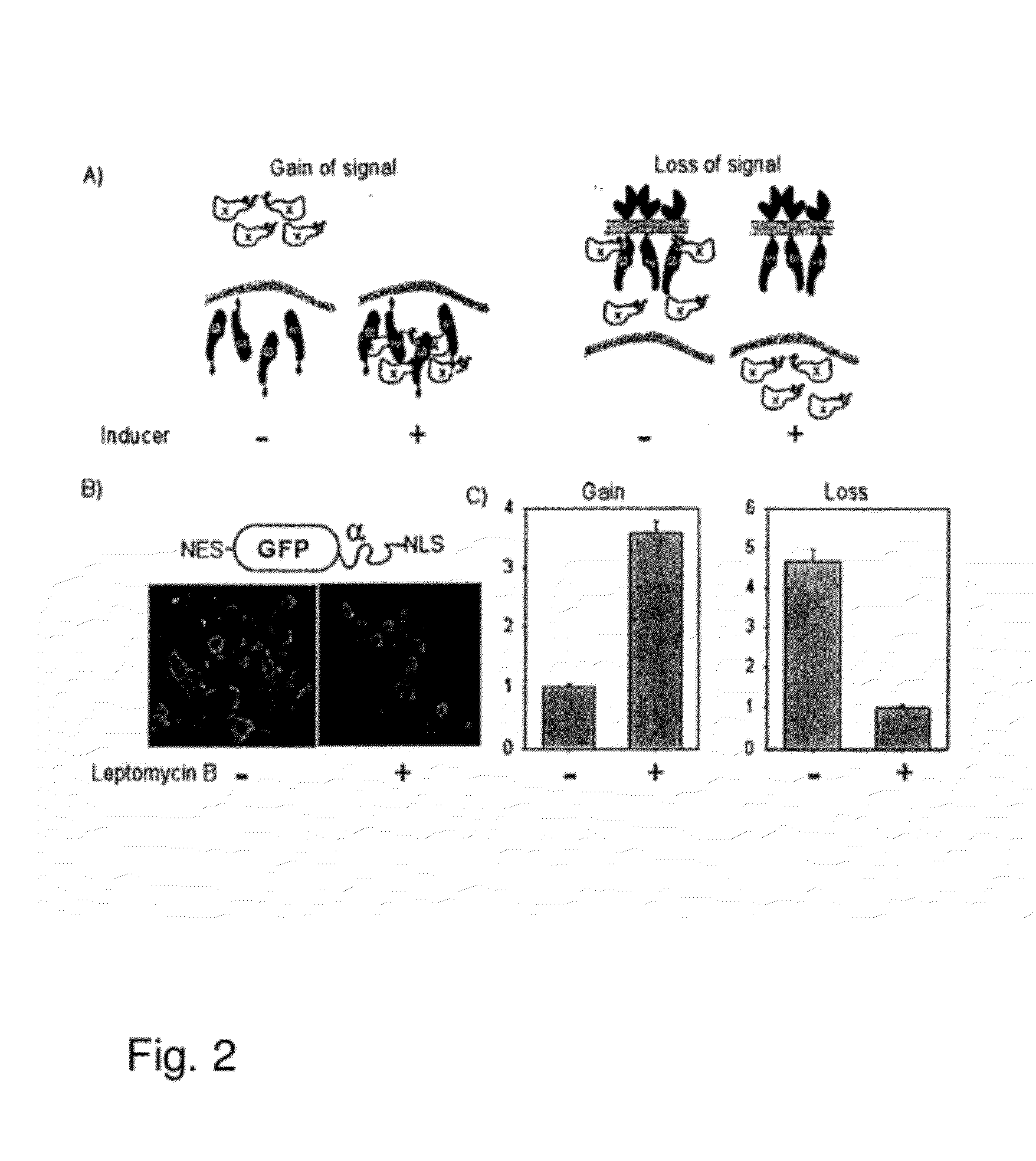Detection of Protein Translocation by Beta-Galactosidase Reporter Fragment Complementation
a reporter fragment and protein technology, applied in the field of molecular biology, can solve the problems of difficult control of stoichiometry and the location of dye attachment, poorly understood mechanisms involved in nuclear translocation and targeting of steroid receptors to regulatory sites in chromatin, and inability to track these events. , to achieve the effect of precise and accurate monitoring
- Summary
- Abstract
- Description
- Claims
- Application Information
AI Technical Summary
Benefits of technology
Problems solved by technology
Method used
Image
Examples
example 1
Design of the Minimal Fragment
[0145]α-complementation of β-galactosidase involves a deletion mutant, the ω fragment (ω), that is missing amino acids 11-41. In E. coli and in vitro, it is possible to complement this mutant in trans by providing the α peptide which encodes amino acids 3-41. However, previous studies in mammalian cells reported that the smallest complementing fragment contained amino acids 1-71. Because a smaller peptide enhances the efficiency of anal sensitivity, the smallest α peptide(s) that would complement robustly in mammalian cells when fused to an exogenous protein at the N or C terminus was determined. The myoblast cell line C2C12 was engineered to stably express the co fragment by retroviral transduction. The α potion of β-galactosidase was fused to the C-terminus of GFP and deletions were made stating at amino acids 137 and continuing through amino acids 38. The products were transduced into the parental cell line expressing the ω-fragment, and the cells we...
example 2
Nuclear Translocation Assay
[0148]In order to utilize a complementation as a method of quantitatively assessing nuclear translocation events, two systems were designed that are distinct in the localization of the ω-fragment. FIG. 2A is a schematic showing the design of the nuclear translocation assay. In the let panel, the ω fragment is localized to the nucleus with a nuclear localization signal (NLS) and the cytosolic protein of interest is fused to the minimal α peptide. Upon stimulation the α fusion moves to the nucleus and complements the co, increasing β-galactosidase activity. In the right panel, the co fragment is tethered to the plasma membrane using the extracellular and transmembrane regions of EGFR. The cytosolic α-fusion complements spontaneously until stimulation when it translocates to the nucleus which results in a loss of enzyme activity.
[0149]The gain of signal assay (FIG. 2A left panel) localized the ω to the nucleus through fusion to a triplet SV40 nuclear localiza...
example 3
α-Peptide Mutants with Diminished Complementation Capacity
[0158]The α peptide used in the nuclear translocation assay had the capability of spontaneously restoring enzyme activity when placed in the same cellular compartment as the co mutant. Although this method is ideal for proteins that can be separated from the ω by a physical barrier, a system to identify translocation events within the same cellular compartment also benefited from α peptides that bind the ω with lower affinity. β-galactosidase is active only as a tetramer. The crystal structure of β-galactosidase shows that residues 5-28 of the α peptide are involved in dimerization of two monomers while residues 31-41 are buried within the ω fragment. Without being bound by theory, mutation of the buried residues could decrease the ability of the α peptide to dock with the ω fragment while maintaining its ability to mediate tetramer formation.
[0159]Several point mutations spanning residues 31-41 were engineered into the α fus...
PUM
| Property | Measurement | Unit |
|---|---|---|
| dissociation constants | aaaaa | aaaaa |
| dissociation constants | aaaaa | aaaaa |
| volume | aaaaa | aaaaa |
Abstract
Description
Claims
Application Information
 Login to View More
Login to View More - R&D
- Intellectual Property
- Life Sciences
- Materials
- Tech Scout
- Unparalleled Data Quality
- Higher Quality Content
- 60% Fewer Hallucinations
Browse by: Latest US Patents, China's latest patents, Technical Efficacy Thesaurus, Application Domain, Technology Topic, Popular Technical Reports.
© 2025 PatSnap. All rights reserved.Legal|Privacy policy|Modern Slavery Act Transparency Statement|Sitemap|About US| Contact US: help@patsnap.com



